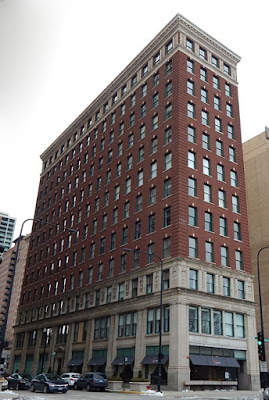In October
1875, John and Frances Glessner attended the Interstate Industrial Exposition,
located in a cavernous W. W. Boyington designed building on the present site of
the Art Institute of Chicago. It was
here that the Glessners saw a collection of artistically designed furniture
organized by Peter B. Wight and William Le Baron Jenney, much of it carved by
Isaac Scott. The long collaboration
between the Glessners and Scott that began at the exposition is
well-known. Often overlooked, however,
is the fact that the Glessners acquired one of their favorite pieces of faience
earthenware at the exposition.
The
Glessners purchased several photographs of the furniture they saw at the
exposition, including a sideboard designed by architect Asa Lyon and carved by
Isaac Scott (shown above). Prominently
displayed at the center of the main shelf is a stately ewer and basin which the
Glessners acquired soon after and placed at the center of the mantelpiece in
their Washington Street parlor (shown below).
The piece
was manufactured by the French firm of Gien, considered one of the finest
faience manufacturers in the 19th century. The company dates back to 1821 when Thomas
Edme Hulm (or Thomas Hall) left his factory at Montereau, which had been
operated by his family for nearly half a century, and purchased the property of
the old convent of Minimes. It was here
that he opened his new factory to produce faience using English methods.
The
earliest pieces were more utilitarian in nature such as crockery, but later he
began producing decorative pieces and dinner services, often copying older
objects that combined both old and new decoration inspired by other
manufacturers in Europe as well as pieces from the Far East.
Photo by Susan Einstein for the
Los Angeles County Museum of Art
Los Angeles County Museum of Art
The
Glessners’ piece is a close copy of Rouen ware produced in the late 17th
and early 18th centuries which made Rouen a major center of French
pottery. A ewer that is very similar to
the Glessners’ piece was exhibited at the Los Angeles County Museum of Art in
2012-2013 as part of their exhibit “Daily Pleasures: French Ceramics from the
MaryLou Boone Collection.” Shown above, the piece was made about 1700 and is
virtually identical in shape including the applied handle, although some
freedom was taken in creating the decorative designs on the Glessners’
ewer.
The period
between 1855 and 1900 is generally considered to be the pinnacle of faience
production in Gien. Their pieces became
known around the world as the firm won many awards at international exhibitions
in 1855, 1867, 1878, 1889, and 1900.
The mark
on the underside of the basin, consisting of three crenelated towers with a
ribbon beneath bearing the name GIEN, indicates that the piece was produced in
the first half of the 1870s. The three
towers design was introduced as a mark for the firm in 1856, and in the
Glessners’ piece, it also features prominently in the decoration. The three towers motif is painted into a
medallion beneath the lip of the ewer, and also serves as the central motif in
the basin.
Additional decoration
includes a royonnant design inside the basin and a variety of richly detailed
floral decorations and foliate scrolls across the body of both the ewer and
basin. The heavy lip of the ewer is
decorated with a twisted rope design.
One
of the most unusual features of the piece is the pair of grotesque masks
forming handles for the basin, which sits atop four pyramidal peg feet.
During the
decades that the Glessners lived on Prairie Avenue, the ewer and basin appear
to have always been on display on the south bookcase in the library near the
doorway to the cork alcove, as shown in the photo below, taken in 1923. Today, the piece is displayed on a side table
in the courtyard bedroom.
In 1986,
the Gien Museum opened in an old clay body cave dating back to the 16th
century. Telling the story of Gien from
1821 to the present, it consists of two large rooms showing both popular and
artistic faience, along with special pieces created for the various World’s
Fairs. Click here for more information
on the museum, located in Gien, France, 78, Place de la Victoire.
Gien is
still produced today and is considered among the highest quality earthenware in
France.








































